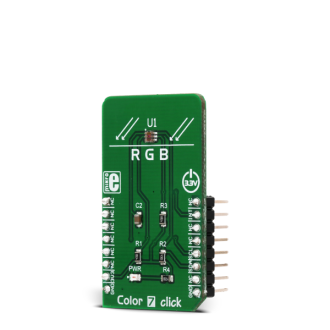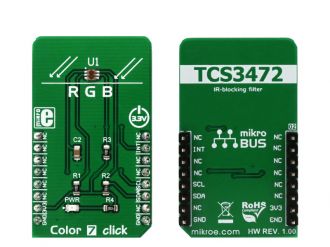
We strongly encourage users to use Package manager for sharing their code on Libstock website, because it boosts your efficiency and leaves the end user with no room for error. [more info]

Rating:
Author: MIKROE
Last Updated: 2018-07-02
Package Version: 1.0.0.0
mikroSDK Library: 1.0.0.0
Category: Optical
Downloaded: 6457 times
Not followed.
License: MIT license
Color 7 click is a very accurate color sensing Click boardâ„¢ which features the TCS3472 color light to digital converter with IR filter, from ams. It contains a 3x4 matrix of photosensitive elements, which can sense red, green, blue and clear light component.
Do you want to subscribe in order to receive notifications regarding "Color 7 click" changes.
Do you want to unsubscribe in order to stop receiving notifications regarding "Color 7 click" changes.
Do you want to report abuse regarding "Color 7 click".


Library Description
The library initializes and defines the I2C bus driver and drivers that offer a choice for writing data in the register. The library includes functions for configuring the chip for measurement, reading one color ratio and light color value. The color value is calculated by converting the RGBC value to HSL value. The user also has the function color7_getColor() which checks the color of the light.
Key functions:
void color7_writeByte(uint8_t reg, uint8_t _data) - Functions for write one byte in registerfloat color7_getColorValue() - Functions for reading the color value in HSL.uint8_t color7_getColor(float color_value) - Functions for detecting colors.float color7_readColorRatio(uint8_t color) - Functions for reading the color ratio.Example description
The application is composed of three sections:
void applicationTask()
{
colorValue = color7_getColorValue();
isColor = color7_getColor(colorValue);
switch(isColor)
{
case 1:
{
mikrobus_logWrite("--- Color: ORANGE ", _LOG_LINE);
break;
}
case 2:
{
mikrobus_logWrite("--- Color: RED ", _LOG_LINE);
break;
}
case 3:
{
mikrobus_logWrite("--- Color: PINK ", _LOG_LINE);
break;
}
case 4:
{
mikrobus_logWrite("--- Color: PURPLE ", _LOG_LINE);
break;
}
case 5:
{
mikrobus_logWrite("--- Color: BLUE ", _LOG_LINE);
break;
}
case 6:
{
mikrobus_logWrite("--- Color: CYAN ", _LOG_LINE);
break;
}
case 7:
{
mikrobus_logWrite("--- Color: GREEN ", _LOG_LINE);
break;
}
case 8:
{
mikrobus_logWrite("--- Color: YELLOW ", _LOG_LINE);
break;
}
default:
{
break;
}
}
Delay_100ms();
}
Other MikroElektronika libraries used in the example:
Additional notes and information
Depending on the development board you are using, you may need USB UART click, USB UART 2 click or RS232 click to connect to your PC, for development systems with no UART to USB interface available on the board. The terminal available in all MikroElektronika compilers, or any other terminal application of your choice, can be used to read the message.